|
The Woodlands, on Penn Road, is one
of Penn’s grandest buildings. Since 1945 it has been the
Woodlands Quaker Home, a private residential home, run
by the Society of Friends. The house was built in the
late 1890s, on the site of an earlier house, originally
called ‘Penn Villa’, but later known as ‘The Woodlands’.
|
| The Early Years The first large scale map of
Staffordshire was produced by William Yates in 1775,
followed by a smaller version in 1798.
The Woodlands
estate is not marked on the 1798 map, and so probably
did not exist at that time. It is however, clearly
marked on the next detailed map of the area, produced
in 1838, by the Ordnance Survey. It is marked as ‘Penn
Villa’. |
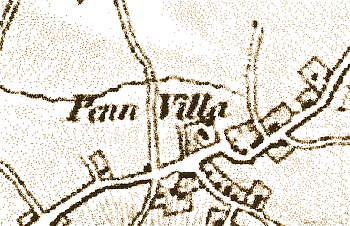
From the 1838 Ordnance Survey map. |
|
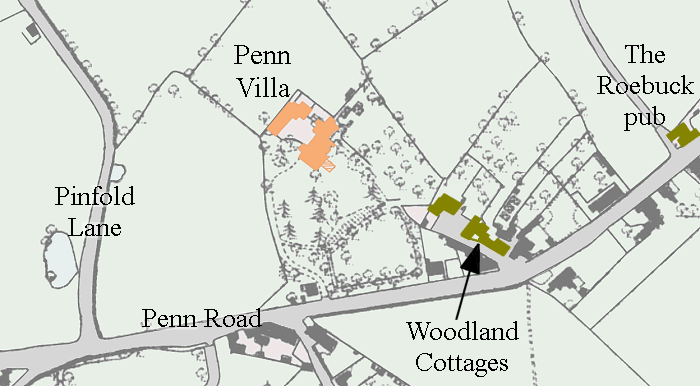
The original house and out
buildings, as marked on the 1885 O.S. map. |
|

The later house and out buildings,
as marked on the 1919 O.S. map. |
| Penn Villa belonged to Thomas
Higgins Burne, who owned much of the surrounding land.
He was born at Himley in 1791, and became a wealthy
land and property owner, who in 1823 moved to Loynton
Hall, near Stafford. |
|
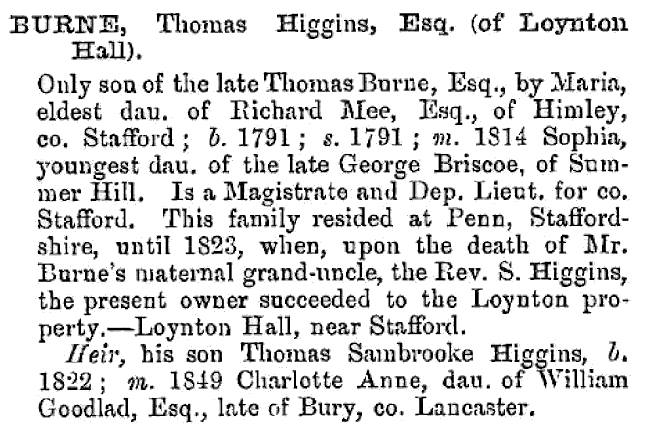
From the 'County Families of the
United Kingdom' by E. Walford. |
|
After his death, some of the estate
was sold at auction, on 31st July, 1861. The sale
included just
over three acres of land behind the Roebuck pub, in two
plots, which were sold to a Mr. Mason for £765. Another
three acres of land, including a house and garden,
opposite the top of Pinfold Lane, was sold to a Mr.
Weaver for £1,265. The house was occupied by Mr. Tudor,
the tenant, and previously by Mr. P. Deakin. Other pieces of land sold at
the auction included one acre at The Butts, three acres
called Perry Pit, three acres near The Hollybush pub,
and just over an acre at Merry Hill. In September 1862, Penn Villa, the
estate, and woodland, was sold to Benjamin Savage for
£3,000. The house then became known as ‘The Woodlands’.
Benjamin and Ann Savage
The Savage family is listed in the
1871 census as follows:
|
The Woodlands, Upper Penn.
Benjamin Savage age 61, born in
Wolverhampton. Wine and hop merchant.
Ann Savage age 59, wife, born in
Wolverhampton.
Children:
Ann Savage age 33, Elizabeth Savage
age 27, Lucy Savage age 23, Frank J. Savage age 25, Jessie
Savage age 21, and Fanny Savage age 19.
Servants:
Marry A. Wheeler age 37, Cook, and
Ann Mason age 28, Housemaid.
|
|
In those days there was a lodge at
the Penn Road end of the drive. In 1881 it was occupied
by Charles Long, age 63, a gardener and domestic
servant, and his family.
Benjamin Savage was born on 15th
May, 1809, and christened at St. Peter’s Church,
Wolverhampton. His parents were Thomas and Mary Savage.
His marriage details are listed in the Penn Parish
Registers, as follows: On the 8th May, 1834, Benjamin
Savage of Kinver, married Ann Smallwood of Penn, at St.
Bartholomew’s, Church, Penn.
Benjamin was a wine and spirit
merchant, a hop merchant, and maltster, based in
Wolverhampton. He also owned a number of properties and
shops in the town. Benjamin and Ann moved to ‘The
Woodlands’ from ‘The Bhylls’, in Bhylls Lane,
Castlecroft, which was purchased by William Butler, the
owner and founder of Butler’s Brewery, who may have been
one of Benjamin’s customers. |
|

The Bhylls, later called
Bellencroft. |
|
Benjamin joined his father’s
business, and eventually ran it himself. His business is
listed in the Wolverhampton section of Melville &
Company's 1851 Directory, as follows: Benjamin Savage,
hop and wine merchant and maltster, Queen Street. Home –
The Bhylls.
During its existence, the business
moved several times, as can be seen from the following
Wolverhampton listings in trade directories:
|
William White’s History, Directory,
and Gazetteer of Staffordshire, 1834: Hop Merchants,
Savage Thomas & Company, Cleveland Road.
Robson’s 1839 Trade Directory: T. &
B. Savage, Cleveland Street, Maltsters, Hop Factors, and
Corn Dealers.
Pigot and Company’s 1842,
Staffordshire Directory: Wine & Spirit Merchants,
Benjamin Savage, Dudley Street.
Slater’s Classified Directory,
1851: Savage Benjamin, malt, hop & wine merchant, Queen
Street
J. G. Harrod & Company’s Postal
Commercial Directory, 1870: Savage & Son, wine, spirit,
and hop merchants and maltsters, 62 Queen Street.
|
|
Benjamin Savage died on the 18th
August, 1876 at the Woodlands, and Ann Savage died on
the 28th June, 1886, also at the Woodlands.
John and Mary Brotherton
In the late 1880s, The Woodlands
was sold to local tube manufacturer John Brotherton, and
his wife Mary. The family is listed in the 1891 census
as follows:
|
The Woodlands, Upper Penn
John Brotherton age 61, Managing
Director of tube works, who was born in Wednesbury.
Mary Anne Brotherton, wife, age 57,
born in Wednesbury.
Children:
Thomas Brotherton age 25,
William F. Brotherton age 21, Alfred C. Brotherton age
20, Albert H. Brotherton age 18, Florence M. Brotherton
age 16, and Harold B. Brotherton age 13.
Servant:
Ethel A. Walker age 22.
|
|
John Brotherton was born in Walsall
Street, Wednesbury, on 20th September, 1829. His parents
were Richard Brotherton, a file cutter, and Mary.
Unfortunately Richard Brotherton died at an early age,
leaving his widow to bring-up her large family.
John started an apprenticeship at
his uncle Cornelius Whitehouse's gas and water tube
works, first working in Wednesbury, and later at his
uncle's Monmore Green Tube Works in Wolverhampton.
Cornelius Whitehouse invented a greatly improved method
of making tubes. His invention led to the development of
the local tube industry, both at Wednesbury and
Wolverhampton.
John moved to Wolverhampton, and in
1861 established the Imperial Tube Works in Bilston
Road, Wolverhampton, in partnership with Wordsworth
Harrison, and John Kelly. The firm produced a wide range
of products including hot water tubes; lap-welded boiler
tubes; artesian and petroleum well tubes; refrigeration
tubes; sealed oven tubes; steel and iron tubes for gas,
water, and steam; fittings for gas water and steam; tuyere; anvil; and other coils; and railway signal and
points rods.
In 1869 John Kelly left the
business, as was reported in the October 1st, 1869
edition of the London Gazette:
|
Notice is hereby given that the
partnership for some time past carried on by Messrs.
Wordsworth Harrison, John Kelly, and John Brotherton, as
Gas Tube Manufacturers, under the firm of John
Brotherton and Company, at Monmore Green Works,
Wolverhampton, in the county of Stafford, was this day
dissolved by mutual consent, so far as regards the said
John Kelly, by his retiring from the said partnership
concern, and the business will from henceforth be
carried on by the said Wordsworth Harrison and John
Brotherton alone, under the firm of John Brotherton and
Company, who will receive and discharge all claims due,
and owing from, or to the said partnership concern. Dated
this 23rd day of September, 1869.
Wordsworth Harrison.
John Brotherton.
John Kelly. |
|
|
|
By 1871 the firm employed around
100 men and 80 boys. In 1886 Imperial Tube Works became a
limited company which was known as John Brotherton
Limited.
In 1897 the New Brotherton Tube Company Limited
was formed, and on 26th October of that year the firm
acquired a second factory, purchased from The Electric
Construction Corporation. It stood on the corner of
Commercial Road and Walsall Street.
By 1914 the firm
employed around 400 people. In 1922 the business was
sold-off.
John and Mary Anne Brotherton were
married in about 1850. In the 1871 census they are
listed as living at 116 Dudley Road, Wolverhampton.
John
is described as an iron tube manufacturer, employing 100
men and 80 boys.
Their children were John E. Brotherton
age 18, Elizabeth Brotherton age 17, Mary A. Brotherton
age 14, Harriett Brotherton age 10, James Brotherton age
9, Annie Brotherton age 7, Thomas B. Brotherton age 5,
William F. Brotherton age 10 months, and Alfred C.
Brotherton age 9 weeks.
|
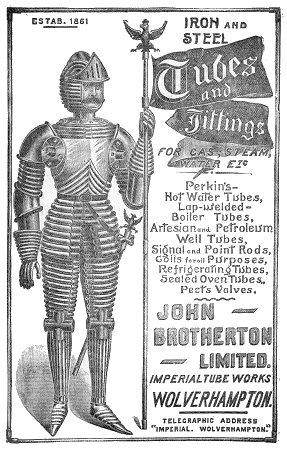
An advert from 1902. |
|
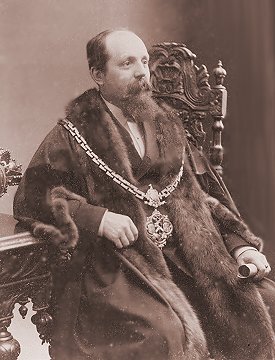
John Brotherton in his mayoral
robes. |
For many years John served on
Wolverhampton Council. He was elected to the council in
1873 as one of the representatives of St. George's Ward,
and became a member of the town's Waterworks Committee, who
significantly improved the local water supply.
In
1883 he became mayor, and greatly contributed to the
town's Fine Arts and Industrial Exhibition in 1884.
In the 1881 census they are listed
as living in Penn Road House, Wolverhampton. By this
time the family had grown to include: Albert aged 8,
Horace aged 6, and Harold aged 3.
The family moved to the Woodlands
in about 1888. On 27th May, 1895, William Frederic
Brotherton, who worked in his father's business as an
agent, married Nellie Florence Gosnell. They moved to
Cricklewood, Middlesex, where he worked as a
representative to an iron tube manufacturer. Presumably
John Brotherton Limited. |
|
By 1896 the Brothertons had left
The Woodlands. They moved to Goldthorn Terrace off
Goldthorn Road. In the 1911 census John and Mary Anne
are listed at 30 Chandos Road, Cricklewood, Willesden,
the home of their son William and his wife Nellie.
Sadly, Mary Anne died in December
1915, and was buried at Merridale Cemetery on 21st of
that month. Almost two years later to the day, John
died. He was buried in the same grave on 15th December,
1917.
When the Brothertons left The
Woodlands, It was purchased by Neville Mander, who
demolished the old house, and replaced it with the house
that is there today.
Neville Hanbury Mander
|
| In 1896, Neville Mander and his wife, Emily,
purchased The Woodlands estate. The house and
outbuildings were demolished, and replaced with the
house that is still there today. A new coach house and
stables were built, and the gardens were redesigned.
Neville, the second son of Charles B. Mander, born in
1862, was delicate in childhood
and suffered throughout his life from a speech impediment.
He was well-liked by the employees
at the family's business; Mander Brothers' varnish and
ink factory, Townwell Works, John Street,
Wolverhampton.
For many years, Neville sat on
several committees at the General Hospital, later known
as the Royal Hospital.
On the 19th June, 1890 he married
Emily Louise Campbell, daughter of Colonel Archibald
Edwardes Campbell, of the Bengal Staffordshire Corps, at
Emmanuel Church, Compton Gifford, Plymouth. |

Neville Hanbury Mander. |
The family is listed in the 1901 census as follows:
| The Woodlands, Upper Penn.
Neville Hanbury Mander age 38,
born in Wolverhampton. Employer,
varnish manufacturer.
Emily Louise Mander age 30,
wife, British Subject, born in
India.
Children:
Hilda age
8, Irene age 2,
Servants:
Annie
Hughes age 35, nurse; Edith
Evans age 19, under nurse; Emma
Rowley age 30, cook; Teresa
Bowyer age29, parlour maid;
Elizabeth Broadhurst age 26,
house maid; Mary James age 22,
house maid; and George H.
Griffiths age 27, coachman, who
lived with his family in the
lodge. |
|
The new house was
designed by London architect H. T. Hare, and built by
the local builder H. Willcock & Company. Features
included an oak-panelled and oak floored inner sitting
hall with a moulded ceiling, a white panelled drawing
room, a pleasant morning room, a dining room, an oak
panelled billiard or music room, 7 principal bedrooms,
and a servants' staircase leading to 5 secondary
bedrooms. A conservatory was built at the rear.
There was also a
servants' hall, a china pantry, 2 kitchens, and a
larder. The house was fitted with central heating
and electric lighting. Outside was a double garage,
a small garage, a double carriage house, and stables
with a saddle room. There was also a wooden shelter
in part of the garden, known as The Paddock.
Neville Mander died on 7th July,
1919, and Horton Estates took over the estate
management. The house was put-up for sale in 1920,
but his wife Emily Louise, and daughter Irene,
continued to live in the house until 1923 when they
moved to Penn Croft.
|
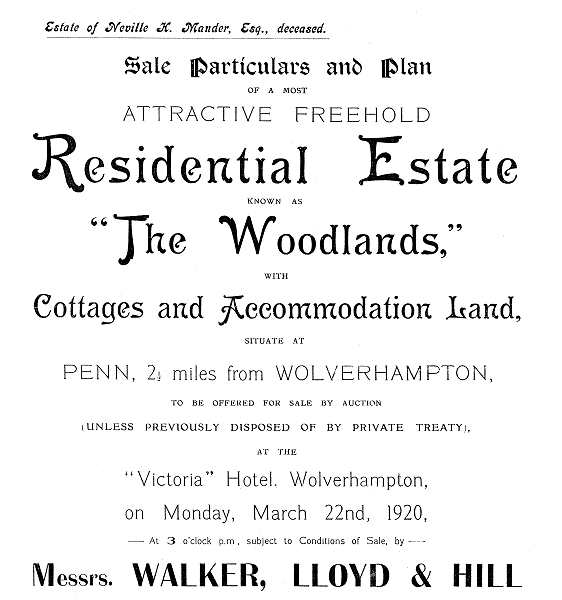 |
The first page of the 1920
sale catalogue. |
| The following photos
are from the sale catalogue: |
|

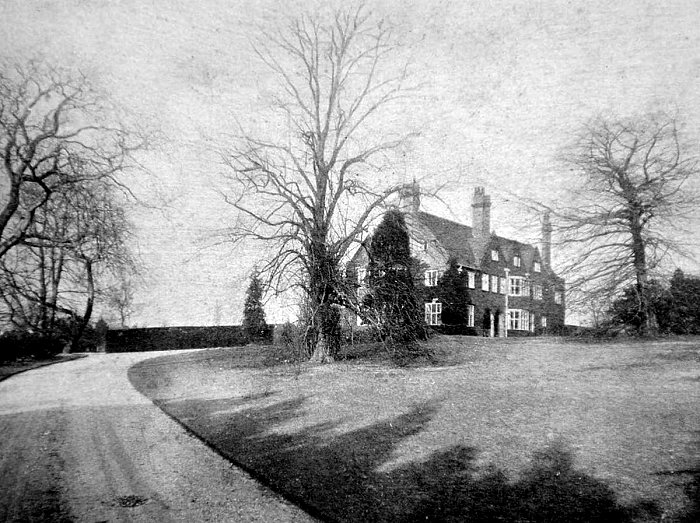
The house and main drive.
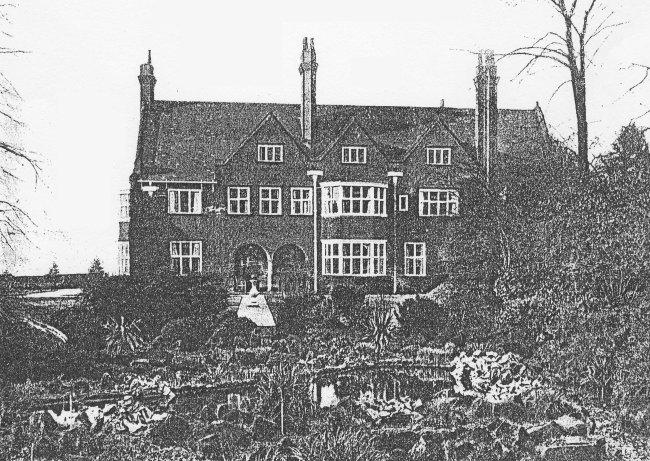
The House and Rock Garden. |
|
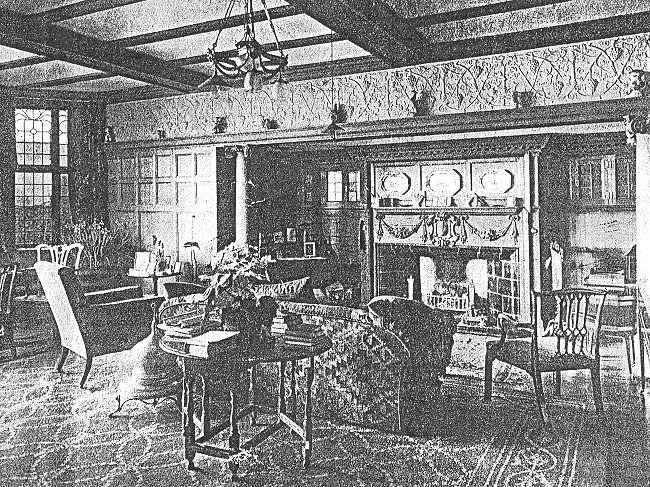
The Music or Billiard Room. |
|
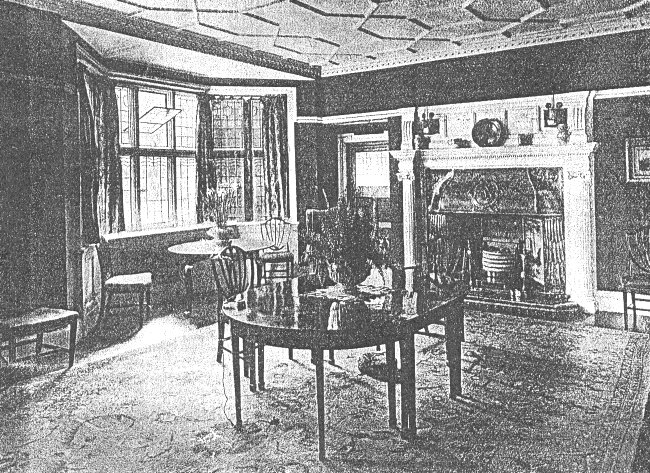
The Drawing Room. |
|
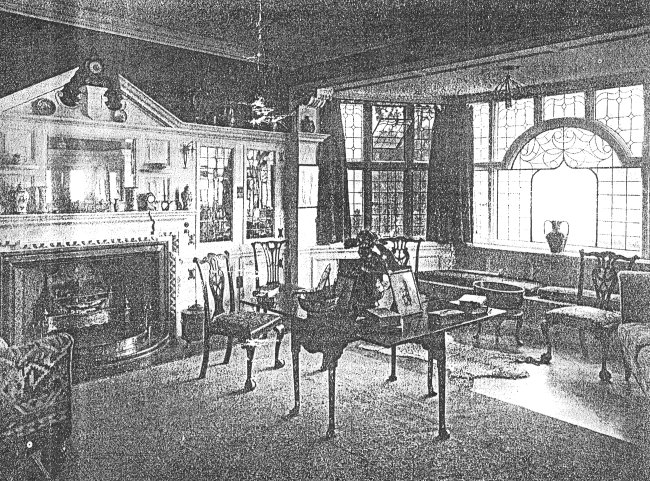
The Dining Room. |
|
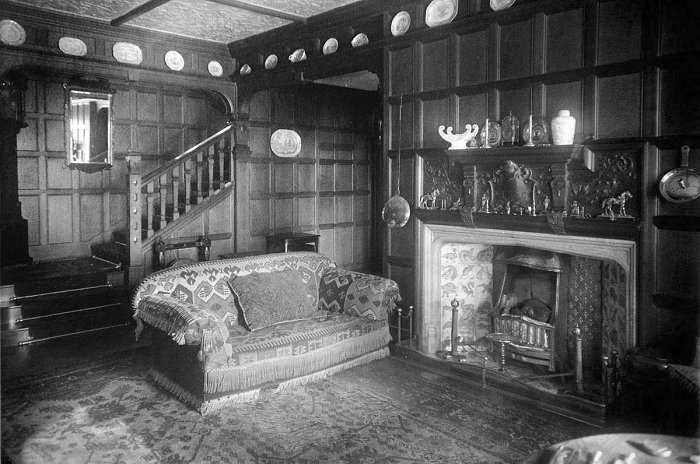
The Inner Sitting Hall. |
|
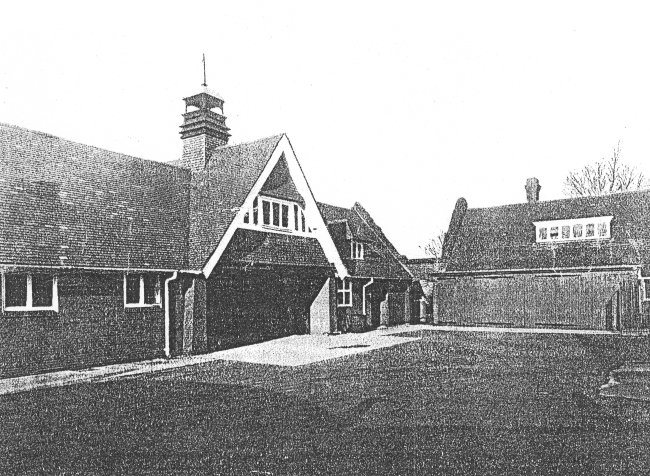
The Stables and garages. |
| George Mason
The woodlands was purchased by the once well-known
grocer George Mason, who owned a large number of grocery
shops. There was at least one in almost every town
centre. He must have moved into the house with his
family in 1923 when Emily and Irene Mander moved to Penn
Croft.
George was born in Blymhill, Staffordshire in 1884.
He learned the grocery trade while working as an
apprentice in a small grocery store in Newport,
Shropshire. In 1901 he formed a grocery company with a
friend, surname Williams, who had worked with him, also
as an apprentice in Newport. They founded Mason and
Williams, and opened their first grocery shop in Lozells
Road, Aston, Birmingham, in 1901. Within five years they had 140
shops in the West Midlands, but the two men fell out and
so the partnership was dissolved. They each took 70
shops, but George, being the better businessman, was
more successful, and gradually purchased the other70
shops from his one-time partner.
He intitially traded as 'May-Sun' and owned factories
to produce his own jam, biscuits, and cakes, and also a
cookhouse in Digbeth that made sausages, and produced
cooked meat. His products were second to none. There
were over 400 members of staff at the head office in
Bradford Street, Digbeth, managed by George's second in
command, Thomas Bridgett. The two were workaholics, and
expected their staff to be the same, slacking was not
tolerated. The business was George's life, he had little
time for anything else.
By the time of his death on 22nd August, 1934, at the
age of 50, he owned nearly 500 shops. The once familiar
George Mason grocery stores were to be found in the West
Midlands, throughout Wales, and Lancashire. George died
at The Woodlands, and left £332,885.18s.1d. in his will.
After his death the business continued to thrive and
expanded to cover most of the country.
A school, a hostel,
and finally a care home
After George Mason’s death, the house became a
school. His executors rented the house to Miss D. M.
Fox, who opened a girls’ school there.
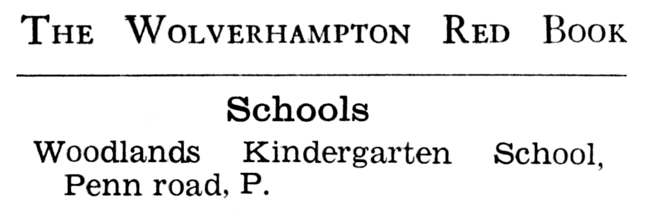
From the 1938-9 Wolverhampton Red
Book.
When the school closed in 1941, the
house became a hostel. The
executors rented the estate to the Friends Relief
Service Committee as a home for evacuees and refugees. As well as making alterations
inside the house, the committee
redeveloped the stables to provide extra accommodation. The
refugees included a party of Mennonites, who were a
Christian group, making their way from Canada to Europe, to help victims of the war.
When the war ended in 1945, the
Society of Friends purchased the estate in order to
create a home for the elderly. They took control of the
estate on 1st November, 1945. Suitable alterations were
made to the house, and it became the Woodlands Quaker
Home. Today the house has 35 residents, and the stables,
now known as 'The Spinney', has 9 bedrooms and facilities
for people suffering from severe dementia. Also on the
estate is 'The Paddock', a building that contains 25
warden-assisted flats.
|

The original entrance
on Penn Road. |
|

The house in about
1946. |
|
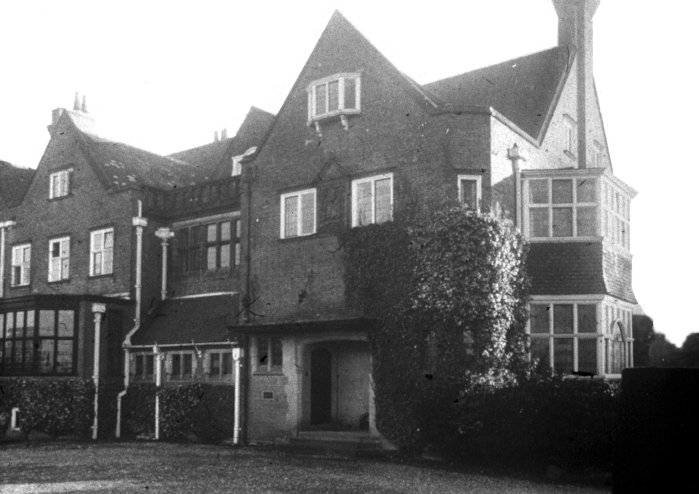
The main entrance to
the house, also in about 1946. |
|
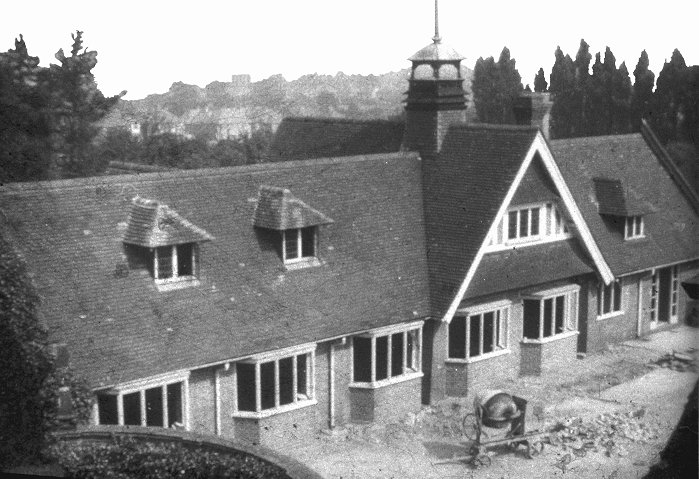
Rebuilding the
stables. |
|

Some of the early
members of staff. |
|
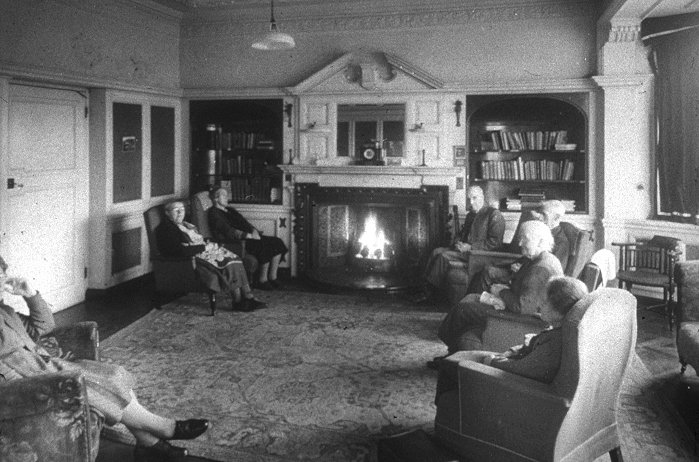
Some of the early
residents in the sitting room. |
|

Another view of the
house, from around 1946. |
|
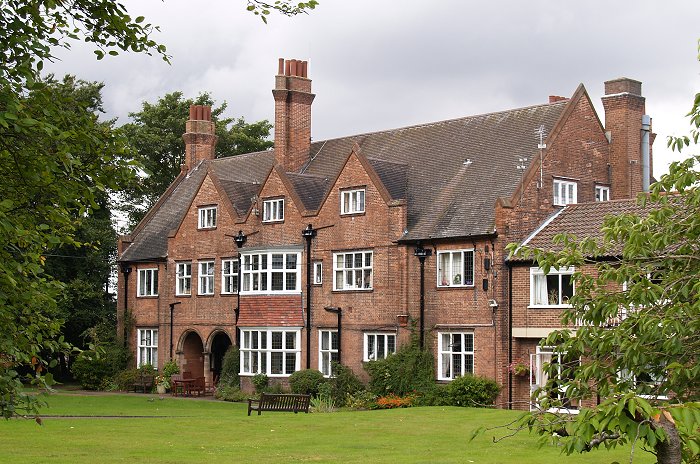
The house, with the
modern extension on the right. As seen in
2012. |
The Woodlands is now known for
its homely atmosphere and high level of quality care.
The lovely house, the well-maintained gardens, and the
home’s reputation for excellent care, now make the
Woodlands Quaker Home a very desirable residence for the
elderly.
|
|
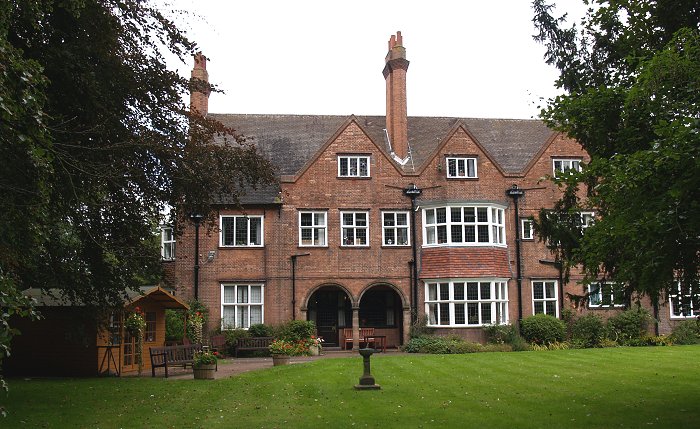
A final view, looking across the
front lawn. |
 |
Return to
the
previous page |
|